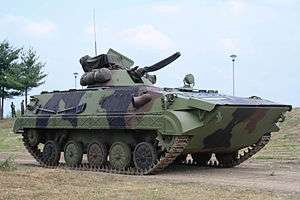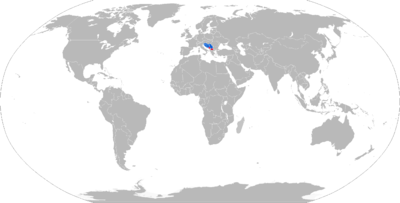BVP M-80
| BVP M-80 ICV/IFV | |
|---|---|
 M-80A | |
| Type | Infantry fighting vehicle |
| Place of origin | Yugoslavia |
| Service history | |
| In service | 1979–present |
| Wars | Yugoslav Wars |
| Production history | |
| Designer | Military Technical Institute Belgrade |
| Designed | 1971‒today, M-80 first version introduced in 1979 |
| Specifications | |
| Weight | 13,850 kg |
| Length | 6.42 meters |
| Width | 2.90 meters |
| Height | 2.20 meters |
| Crew | 3+7 |
|
| |
| Armor | Aluminum/Aluminum oxide/Titanium boride |
Main armament | 20 mm M-55 (HS 804) cannon 400 rounds9M14 Malyutka (AT-3 Sagger) ATGW 2 Missiles or ATGM launcher |
Secondary armament | coaxial 7.62 machine-gun 2,000 rounds |
| Engine |
Daimler Benz OM-403 320 hp |
| Power/weight | 22.6 hp/tonne |
| Suspension | torsion bar |
Operational range | 500 km |
| Speed | 65 km/h on land8 km/h in water |
The BVP M-80, is a tracked Yugoslavian-made infantry fighting vehicle, produced from the 1980s until the country's collapse in the 1990s.
Development
Early research and development of the M-80 began in 1969, with testing of the first completed prototype in 1974. First examples of the BVP M-80 rolled out in 1979 but full entry to service happened in 1982. An upgraded model was unveiled a year after with a designation M-80A. This variant had a more powerful engine and somewhat better armor. Around 800 vehicles were produced before the breakup of the country.
The first production variant was the M-80 which was only made in small numbers. The vehicle used a French built engine with an output of 260 hp, the same engine as used in AMX-10P. After only a year, Yugoslavia started license production of Daimler-Benz's 320 hp engine in domestic FAMOS factories. This variant received a new designation as M-80A.[1]
At the time it was produced, M-80A had similar characteristics with existing IFVs like Russian BMP-1 or French AMX 10P. Although many foreign experts compare M-80A with Russian BMP-1, the Yugoslav IFV is a true original design. Unlike the BMP-1 which had 6 support wheels and was armed with 73 mm gun, M-80A had 5 support wheels and had 20 mm gun. M-80A incorporates numerous elements from the newer BMP-2 and the French AMX-10P giving it more power and better protection over its counterpart. All M-80As are amphibious and are equipped with twin AT-3 launchers.
It was used extensively during the Yugoslav Wars.[1]
Turret
Initial examples of BVP M-80 mounted a 20mm auto-cannon that has an effective range of about 1500 meters and, depending on ammunition type, is able to penetrate around 20mm of RHAe (Rolled Homogeneous Armour equivalency). These initial vehicles are designated: BVP M-80(A).
In 1978 the technical-military council of Yugoslav People's Army decided that a larger caliber gun would be necessary to counter the increasingly heavy armor of possible enemy armored fighting vehicles and began development of a new turret to house the larger weapon. This requirement led to the development of the Zastava 30mm auto-cannon M86 in 1985[2] and a new turret "Vidra" - later designated: M-91. In addition to the new gyro stabilized 30mm auto-cannon, the new turret was equipped with smoke grenade launchers, improved day/night sights, and the ability to fire SACLOS 9M14 Malyutka ATMs. The turret is rotated by servo-hydraulics and the main gun is elevated and depressed by electric motor. BVP M-80 mounting the Vidra turret are designated: M-80A1.
Incremental improvements were made to the design of the Vidra turret throughout the late 1990's and early 2000's. These improvements would eventually be standardized and incorporated into a thoroughly updated turret and designated: M-91E. Besides being able to mount the original M-86 30mm auto-cannon, the M91-E turret is able to accommodate the dual feed Zastava M-89 30mm auto-cannon.
Development is ongoing on a further modernized turret incorporating more effective ATGM armament.
Besides BVP M-80 versions, the Vidra turret is offered for modernization or production with other vehicles such as BTR-50.
Characteristics
The M-80A is armed with one 20 mm gun, co-axial machine gun 7.62 mm and twin launcher for wire guided anti-tank missiles. It is NBC protected, fire suppression system, inside heating and water ejecting system. It’s fully amphibious and can perform crossing of any water barrier without previous preparations. Max. speed at water is 7 km/h. Crew consist of three, driver, commander and gun operator and in the after compartment there is space for six fully equipped infantrymen who can engage the enemy with personal armament through six gun slits on both vehicle sides and back doors and one squad leader who commands infantry upon exiting the vehicle. Infantry leaves IFV through two doors at the back of the vehicle.[3]
Variants
- M-80 - First production model with 260 hp engine, replaced after 1 year.[4]
- M-80A - Improved version with 320 hp engine, full production.[5]
- M-80A1 - Improved version with new turret called "Vidra" M-91.
- M-80A/98 - Further improvements of M-80A1 with new turret called "Vidra" first designated as M-96 latter changed to M80A/98. Publicly presented in 2004;
- M-80A KC - Company commander's vehicle.
- M-80A KB - Battalion commander's vehicle.
- M-80A Sn - Medical, no turret. Single oblong hatch in the roof and single rear door. Carries 4 stretcher patients or 6 seated patients.
- M-80A LT - Tank hunter version with six AT-3 launchers.
- Sava M-90 - SA-13 Surface-to-air missile launcher, designated Strela-10MJ, prototype.
- SPAT 30/2 - Self-Propelled Ant-aircraft gun. New turret model called "Foka" with two Zastava 30mm cannons with elevation from -5 to +85 degrees. The aim-scan gear is J-171 or Motorola 6800. Included receiver of radar data gathered from external Air Force observations radar. Three crew members and 4 soldiers could be transported. Planned to be used as successor and replacement for M-53/59 Praga - 4 models produced.[6]
- MOS - Self-propelled mine layer.
- M-80AK/M-98A - new gun turret with 30mm M86 cannon or 30mm dual feed M89 cannon.[7]
- M-80AB1 - Latest upgraded variant including more advanced armour, turret gun control equipment, optronics package, smoke grenade launchers and the ability to mount and launch the most recent 9M14 Malyutka missile variants.[8]



Operators

Current operators




Former operators
.svg.png)
References
| Wikimedia Commons has media related to BVP M80. |
- Jane’s tanks and combat vehicles recognition guide, Christopher F. Foss, Harper Collins Publishers, 2000.
- 1 2 "The BVP M80 IFV". Tanknutdave.com. 2010-04-14. Retrieved 2010-09-07.
- ↑ http://www.zastava-arms.rs/en/imagetext/1970-1992
- ↑ ARG. "M-80A at". Military-today.com. Retrieved 2010-09-07.
- ↑ (in Serbian)
- ↑ (in Serbian)
- ↑ http://www.zastava-arms.rs/en/imagetext/1970-1992
- ↑ (in Serbian)
- ↑ Foss, Christopher F (5 July 2017). "Serbia showcases upgraded BVP M-80AB1 IFV". IHS Jane's 360. Belgrade, Serbia. Archived from the original on 5 July 2017. Retrieved 5 July 2017.
- ↑ Armed Forces of Bosnia and Herzegovina